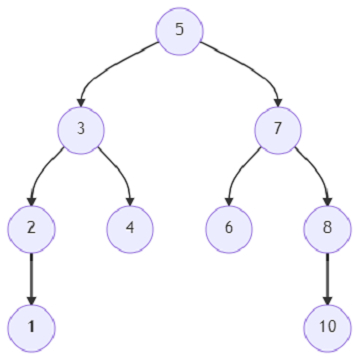
 Data Structure
Data Structure Networking
Networking RDBMS
RDBMS Operating System
Operating System Java
Java MS Excel
MS Excel iOS
iOS HTML
HTML CSS
CSS Android
Android Python
Python C Programming
C Programming C++
C++ C#
C# MongoDB
MongoDB MySQL
MySQL Javascript
Javascript PHP
PHP
- Selected Reading
- UPSC IAS Exams Notes
- Developer's Best Practices
- Questions and Answers
- Effective Resume Writing
- HR Interview Questions
- Computer Glossary
- Who is Who
Program to find out the lowest common ancestor of a binary tree using Python
Suppose, we are given a binary tree and also two specific nodes x and y. We have to find out the lowest common ancestor of the two nodes from the binary tree. The lowest common ancestor in a binary tree is the lowest node of which both the nodes x and y are descendants of. Also, a particular node can also be a descendant of itself. We have to find the node and return it as an output.
So, if the input is like

and x = 2, y = 4; then the output will be 3.
The node of which the nodes 2 and 4 are descendant of is 3. So, 3 will be returned.
To solve this, we will follow these steps −
-
Define a function dfs() . This will take node
-
if node is similar to null, then
return
-
if node is present in list [x,y], then
left := dfs(left of node)
right := dfs(right of node)
-
if left or right is non-zero, then
ans := node
return node
left := dfs(left of node)
right := dfs(right of node)
-
if left and right is not null, then
ans := node
return node
return left or right
-
ans := dfs(root)
return ans
Example
class TreeNode: def __init__(self, data, left = None, right = None): self.data = data self.left = left self.right = right def insert(temp,data): que = [] que.append(temp) while (len(que)): temp = que[0] que.pop(0) if (not temp.left): if data is not None: temp.left = TreeNode(data) else: temp.left = TreeNode(0) break else: que.append(temp.left) if (not temp.right): if data is not None: temp.right = TreeNode(data) else: temp.right = TreeNode(0) break else: que.append(temp.right) def make_tree(elements): Tree = TreeNode(elements[0]) for element in elements[1:]: insert(Tree, element) return Tree def search_node(root, element): if (root == None): return None if (root.data == element): return root res1 = search_node(root.left, element) if res1: return res1 res2 = search_node(root.right, element) return res2 def solve(root, x, y): def dfs(node): if not node: return if node in [x,y]: left = dfs(node.left) right = dfs(node.right) if left or right: ans = node return node left = dfs(node.left) right = dfs(node.right) if left and right: ans = node return node return left or right ans = dfs(root) return ans root = make_tree([5, 3, 7, 2, 4, 1, 7, 6, 8, 10]) print(solve(root, search_node(root, 2), search_node(root, 4)).data)
Input
make_tree([5, 3, 7, 2, 4, 1, 7, 6, 8, 10]), search_node(root, 2), search_node(root, 4)
Output
3

